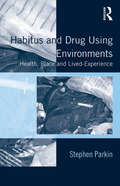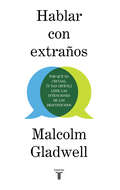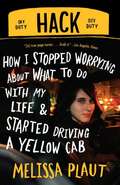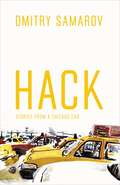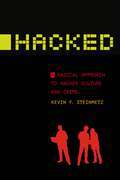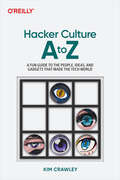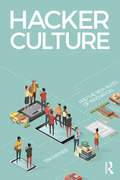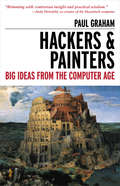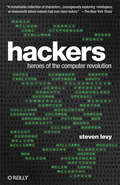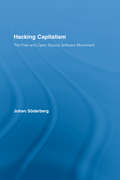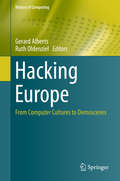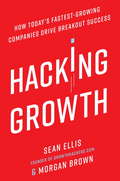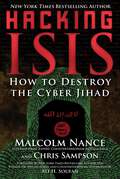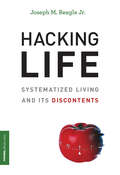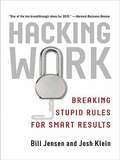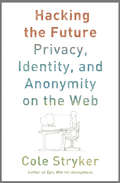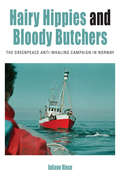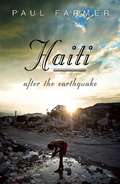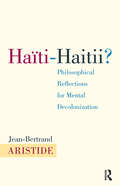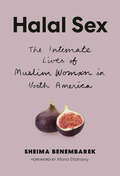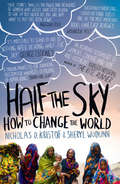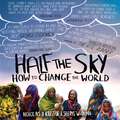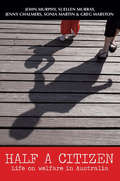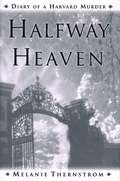- Table View
- List View
Habitus and Drug Using Environments: Health, Place and Lived-Experience
by Stephen ParkinInformed by the thought of Pierre Bourdieu and framed by the philosophy of harm reduction, Habitus and Drug Using Environments provides a sociological analysis of public environments affected by injecting drug use. Drawing on ethnographic research across several locations, this book offers a qualitative and phenomenological account of the social organisation of public settings used for the preparation and administration of illicit drugs, informed by interviews with both injecting drug users and those whose employment is directly affected by public injecting drug use. With attention to current policy-related questions concerning the lived experience of ’place’ upon the health of injecting drug users, how wider social structures contribute to participation in public injecting and the manner in which participation in public injecting amplifies drug-related harm, Habitus and Drug Using Environments sheds light on the ways in which health and place interact to produce and reproduce already established hazards associated with injecting drug use. As such, it will be of interest to sociologists, geographers, criminologists and policy makers working in fields such as drug use, risk behaviours and their relation to place, and health studies.
Habitus, Ressourcen und Studienstrukturen: Passungen und Nicht-Passungen im Fachhochschulstudium
by Sabine EvertzWie erleben Studierende ihr Studium und wie hängt dieses Erleben mit ihren Habitusmustern und Ressourcenausstattungen zusammen? Die soziologische Studie widmet sich aus ungleichheitstheoretischer Perspektive den Passungen und Nicht-Passungen im Fachhochschulstudium. Ergründet wurden Konstellationen von Habitusmustern, Ressourcenausstattungen und Studienstrukturen. Bei den Studienstrukturen handelt es sich unter anderem um studienorganisatorische Strukturen wie die Stundenplangestaltung, um unmittelbar auf die Lehre bezogene Strukturen wie Lehrmethoden und Prüfungsformen oder auch um Strukturen, die im Besonderen das soziale Miteinander betreffen wie die Studienatmosphäre. Die Ergebnisse basieren auf der Analyse von Leitfadeninterviews mit Studierenden der Studienfächer Soziale Arbeit und Maschinenbau sowie auf der Auswertung von Wochenbüchern, die Erstsemesterstudierende in der Studieneingangsphase verfasst haben.
Hablar con extraños: Por qué es crucial (y tan difícil) leer las interacciones de los desconocidos
by Malcolm GladwellVUELVE EL MEJOR GLADWELL, autor de El punto clave, Inteligencia intuitiva y Fuera de serie. «Si puedo convencerte de una única cosa con este libro, que sea esta: los desconocidos no son simples.» ¿Cómo pudo un espía pasar años sin ser detectado en los más altos niveles del Pentágono? ¿Qué llevó a Neville Chamberlain a creer que podía confiar en Adolf Hitler? ¿Qué tienen en común esos casos con el engaño de Bernie Madoff, el juicio de Amanda Knox, el suicidio de Sylvia Plath o la comedia de televisión Friends? Cuando interactuamos con desconocidos, a menudo las cosas no salen bien, en parte porque creemos adivinar las intenciones de los demás basándonos en pistas terriblemente endebles. En Hablar con extraños, Malcolm Gladwell, el autor que ha conquistado a una legión de admiradores con su particular manera de ver el mundo, entrevista a toda una serie de personas brillantes, ofrece un arsenal de ejemplos divertidos, contraintuitivos y convincentes, extrae de ellos ideas poderosas y las condimenta con abundantes datos inolvidables. Al mostrarnos por qué se nos da tan mal leer entre líneas, revela las claves para lidiar mejor con los desconocidos en nuestra vida. En este nuevo viaje a lo inesperado, Gladwell nos ofrece nuevos y valiosos descubrimientos sobre nosotros mismos, pasados por el prisma de la historia, la psicología y la sociología. La crítica ha dicho:«Excelente escritura, estructura magistral, datos llamativos elegantemente reutilizados. La fórmula que hizo que sus libros anteriores fueran éxitos.»Financial Times «Irresistible, y dará que hablar. En un momento de máxima polarización, un libro que examina el modo en que fallamos a la hora de comunicarnos no podría ser más oportuno. Se devora como si fuera un thriller.»Chris Barton, Los Angeles Times «Hay un momento de la lectura en el que incluso el escéptico comienza a sentir que nos estamos equivocando en todo y que quizá este tal Gladwell ha dado con algo... Hablar con extraños es el más sólido de sus títulos.»Amy Chozick, The New York Times «Gladwell ofrece poderosos consejos para entender mejor a los otros. Defiende brillantemente que nadie es transparente y la necesidad de comprender que los comportamientos dependen de circunstancias invisibles.»People «Los casos que analiza Galdwell son sensacionales. Repleto de fascinantes anécdotas, de las cuales extrae pequeñas píldoras sobre cómo relacionarnos con los desconocidos.»Maggie Taft, Booklist «Intelectualmente estimulante, otro tour de force de Gladwell. Los lectores que esperen una nueva lectura adictiva del tipo "nada-de-lo-que-dabas-por-sentado-es-así" no se verán defraudados.»Kirkus Reviews «Fascinante yoportuno. Gladwell escribe con su característica prosa colorida, fluida y accesible.»Publishers Weekly «Adoro este libro. No solo cambia el modo en que vemos a los extraños, sino también cómo entendemos las noticias, el mundo y a nosotros mismos. Transformador.»Oprah Winfrey «Uno de los mejores observadores de su generación, un pensador de amplio espectro que nos ayuda a comprender la condición humana.»Bob Brisco, WebMD Magazine «Gladwell tiene un inmenso talento: una mente aguda, original e inquisitiva, la capacidad de desenterrar información que otros no han considerado y darle un sentido más amplio. Su habilidad narrativa es inigualable.»Stephen Galloway, The Hollywood Reporter
Hack: How I Stopped Worrying About What to Do with My Life and Started Driving a Yellow Cab
by Melissa PlautIn her late 20s, Plaut decided to honor a long-held secret ambition by becoming a New York City taxi driver. With wit and insight, she recreates the crazy parade of humanity that passes through her cab and shows how this grueling work provides her with a greater sense of self.
Hack: Stories from a Chicago Cab (Chicago Visions And Revisions Ser.)
by Dmitry SamarovCabdrivers and their yellow taxis are as much a part of the cityscape as the high-rise buildings and the subway. We hail them without thought after a wearying day at the office or an exuberant night on the town. And, undoubtedly, taxi drivers have stories to tell—of farcical local politics, of colorful passengers, of changing neighborhoods and clandestine shortcuts. No one knows a city’s streets—and thus its heart—better than its cabdrivers. And from behind the wheel of his taxi, Dmitry Samarov has seen more of Chicago than most Chicagoans will hope to experience in a lifetime. An artist and painter trained at the School of the Art Institute of Chicago, Samarov began driving a cab in 1993 to make ends meet, and he’s been working as a taxi driver ever since. In Hack: Stories from a Chicago Cab, he recounts tales that will delight, surprise, and sometimes shock the most seasoned urbanite. We follow Samarov through the rhythms of a typical week, as he waits hours at the garage to pick up a shift, ferries comically drunken passengers between bars, delivers prostitutes to their johns, and inadvertently observes drug deals. There are long waits with other cabbies at O’Hare, vivid portraits of street corners and their regular denizens, amorous Cubs fans celebrating after a game at Wrigley Field, and customers who are pleasantly surprised that Samarov is white—and tell him so. Throughout, Samarov’s own drawings—of his fares, of the taxi garage, and of a variety of Chicago street scenes—accompany his stories. In the grand tradition of Nelson Algren, Saul Bellow, Mike Royko, and Studs Terkel, Dmitry Samarov has rendered an entertaining, poignant, and unforgettable vision of Chicago and its people.
Hacked: A Radical Approach to Hacker Culture and Crime (Alternative Criminology #2)
by Kevin F. SteinmetzInside the life of a hacker and cybercrime culture. Public discourse, from pop culture to political rhetoric, portrays hackers as deceptive, digital villains. But what do we actually know about them? In Hacked, Kevin F. Steinmetz explores what it means to be a hacker and the nuances of hacker culture. Through extensive interviews with hackers, observations of hacker communities, and analyses of hacker cultural products, Steinmetz demystifies the figure of the hacker and situates the practice of hacking within the larger political and economic structures of capitalism, crime, and control.This captivating book challenges many of the common narratives of hackers, suggesting that not all forms of hacking are criminal and, contrary to popular opinion, the broader hacker community actually plays a vital role in our information economy. Hacked thus explores how governments, corporations, and other institutions attempt to manage hacker culture through the creation of ideologies and laws that protect powerful economic interests. Not content to simply critique the situation, Steinmetz ends his work by providing actionable policy recommendations that aim to redirect the focus from the individual to corporations, governments, and broader social issues. A compelling study, Hacked helps us understand not just the figure of the hacker, but also digital crime and social control in our high-tech society.
Hacker Culture A to Z: A Fun Guide to the People, Ideas, and Gadgets That Made the Tech World
by Kim CrawleyHacker culture can be esoteric, but this entertaining reference is here to help. Written by longtime cybersecurity researcher and writer Kim Crawley, this fun reference introduces you to key people and companies, fundamental ideas, and milestone films, games, and magazines in the annals of hacking. From airgapping to phreaking to zombie malware, grasping the terminology is crucial to understanding hacker culture and history.If you're just getting started on your hacker journey, you'll find plenty here to guide your learning and help you understand the references and cultural allusions you come across. More experienced hackers will find historical depth, wry humor, and surprising facts about familiar cultural touchstones.Understand the relationship between hacker culture and cybersecurityGet to know the ideas behind the hacker ethos, like "knowledge should be free" Explore topics and publications central to hacker culture, including 2600 MagazineAppreciate the history of cybersecurityLearn about key figures in the history of hacker cultureUnderstand the difference between hackers and cybercriminals
Hacker Culture and the New Rules of Innovation
by Tim RaynerFifteen years ago, a company was considered innovative if the CEO and board mandated a steady flow of new product ideas through the company’s innovation pipeline. Innovation was a carefully planned process, driven from above and tied to key strategic goals. Nowadays, innovation means entrepreneurship, self-organizing teams, fast ideas and cheap, customer experiments. Innovation is driven by hacking, and the world’s most innovative companies proudly display their hacker credentials. Hacker culture grew up on the margins of the computer industry. It entered the business world in the twenty-first century through agile software development, design thinking and lean startup method, the pillars of the contemporary startup industry. Startup incubators today are filled with hacker entrepreneurs, running fast, cheap experiments to push against the limits of the unknown. As corporations, not-for-profits and government departments pick up on these practices, seeking to replicate the creative energy of the startup industry, hacker culture is changing how we think about leadership, work and innovation. This book is for business leaders, entrepreneurs and academics interested in how digital culture is reformatting our economies and societies. Shifting between a big picture view on how hacker culture is changing the digital economy and a detailed discussion of how to create and lead in-house teams of hacker entrepreneurs, it offers an essential introduction to the new rules of innovation and a practical guide to building the organizations of the future.
Hackers & Painters: Big Ideas from the Computer Age
by Paul Graham"The computer world is like an intellectual Wild West, in which you can shoot anyone you wish with your ideas, if you're willing to risk the consequences. " --from Hackers & Painters: Big Ideas from the Computer Age, by Paul GrahamWe are living in the computer age, in a world increasingly designed and engineered by computer programmers and software designers, by people who call themselves hackers. Who are these people, what motivates them, and why should you care?Consider these facts: Everything around us is turning into computers. Your typewriter is gone, replaced by a computer. Your phone has turned into a computer. So has your camera. Soon your TV will. Your car was not only designed on computers, but has more processing power in it than a room-sized mainframe did in 1970. Letters, encyclopedias, newspapers, and even your local store are being replaced by the Internet.Hackers & Painters: Big Ideas from the Computer Age, by Paul Graham, explains this world and the motivations of the people who occupy it. In clear, thoughtful prose that draws on illuminating historical examples, Graham takes readers on an unflinching exploration into what he calls "an intellectual Wild West."The ideas discussed in this book will have a powerful and lasting impact on how we think, how we work, how we develop technology, and how we live. Topics include the importance of beauty in software design, how to make wealth, heresy and free speech, the programming language renaissance, the open-source movement, digital design, internet startups, and more.
Hackers: Heroes of the Computer Revolution - 25th Anniversary Edition
by Steven LevyThis 25th anniversary edition of Steven Levy's classic book traces the exploits of the computer revolution's original hackers -- those brilliant and eccentric nerds from the late 1950s through the early '80s who took risks, bent the rules, and pushed the world in a radical new direction. With updated material from noteworthy hackers such as Bill Gates, Mark Zuckerberg, Richard Stallman, and Steve Wozniak, Hackers is a fascinating story that begins in early computer research labs and leads to the first home computers.Levy profiles the imaginative brainiacs who found clever and unorthodox solutions to computer engineering problems. They had a shared sense of values, known as "the hacker ethic," that still thrives today. Hackers captures a seminal period in recent history when underground activities blazed a trail for today's digital world, from MIT students finagling access to clunky computer-card machines to the DIY culture that spawned the Altair and the Apple II.
Hacking Capitalism: The Free and Open Source Software Movement (Routledge Research in Information Technology and Society)
by Johan SöderbergThe Free and Open Source Software (FOSS) movement demonstrates how labour can self-organise production, and, as is shown by the free operating system GNU/Linux, even compete with some of the worlds largest firms. The book examines the hopes of such thinkers as Friedrich Schiller, Karl Marx, Herbert Marcuse and Antonio Negri, in the light of the recent achievements of the hacker movement. This book is the first to examine a different kind of political activism that consists in the development of technology from below.
Hacking Europe
by Ruth Oldenziel Gerard AlbertsHacking Europe traces the user practices of chopping games in Warsaw, hacking software in Athens, creating chaos in Hamburg, producing demos in Turku, and partying with computing in Zagreb and Amsterdam. Focusing on several European countries at the end of the Cold War, the book shows the digital development was not an exclusively American affair. Local hacker communities appropriated the computer and forged new cultures around it like the hackers in Yugoslavia, Poland and Finland, who showed off their tricks and creating distinct "demoscenes. " Together the essays reflect a diverse palette of cultural practices by which European users domesticated computer technologies. Each chapter explores the mediating actors instrumental in introducing and spreading the cultures of computing around Europe. More generally, the "ludological" element--the role of mischief, humor, and play--discussed here as crucial for analysis of hacker culture, opens new vistas for the study of the history of technology.
Hacking Growth: How Today's Fastest-Growing Companies Drive Breakout Success
by Morgan Brown Sean EllisThe definitive playbook by the pioneers of Growth Hacking, one of the hottest business methodologies in Silicon Valley and beyond.It seems hard to believe today, but there was a time when Airbnb was the best-kept secret of travel hackers and couch surfers, Pinterest was a niche web site frequented only by bakers and crafters, LinkedIn was an exclusive network for C-suite executives and top-level recruiters, Facebook was MySpace’s sorry step-brother, and Uber was a scrappy upstart that didn’t stand a chance against the Goliath that was New York City Yellow Cabs. So how did these companies grow from these humble beginnings into the powerhouses they are today? Contrary to popular belief, they didn’t explode to massive worldwide popularity simply by building a great product then crossing their fingers and hoping it would catch on. There was a studied, carefully implemented methodology behind these companies’ extraordinary rise. That methodology is called Growth Hacking, and it’s practitioners include not just today’s hottest start-ups, but also companies like IBM, Walmart, and Microsoft as well as the millions of entrepreneurs, marketers, managers and executives who make up the community of GrowthHackers.com.Think of the Growth Hacking methodology as doing for market-share growth what Lean Start-Up did for product development, and Scrum did for productivity. It involves cross-functional teams and rapid-tempo testing and iteration that focuses customers: attaining them, retaining them, engaging them, and motivating them to come back and buy more. An accessible and practical toolkit that teams and companies in all industries can use to increase their customer base and market share, this book walks readers through the process of creating and executing their own custom-made growth hacking strategy. It is a must read for any marketer, entrepreneur, innovator or manger looking to replace wasteful big bets and "spaghetti-on-the-wall" approaches with more consistent, replicable, cost-effective, and data-driven results.
Hacking ISIS: How to Destroy the Cyber Jihad
by Malcolm Nance Christopher SampsonThis book is written by two of the leading terrorist experts in the world - Malcolm Nance, NBC News/MSNBC terrorism analyst and Christopher Sampson, cyber-terrorist expert. Malcolm Nance is a 35 year practitioner in Middle East Special Operations and terrorism intelligence activities. Chris Sampson is the terrorism media and cyber warfare expert for the Terror Asymmetric Project and has spent 15 years collecting and exploiting terrorism media. For two years, their Terror Asymmetrics Project has been attacking and exploiting intelligence found on ISIS Dark Web operations.Hacking ISIS will explain and illustrate in graphic detail how ISIS produces religious cultism, recruits vulnerable young people of all religions and nationalities and disseminates their brutal social media to the world.More, the book will map out the cyberspace level tactics on how ISIS spreads its terrifying content, how it distributes tens of thousands of pieces of propaganda daily and is winning the battle in Cyberspace and how to stop it in its tracks.Hacking ISIS is uniquely positioned to give an insider’s view into how this group spreads its ideology and brainwashes tens of thousands of followers to join the cult that is the Islamic State and how average computer users can engage in the removal of ISIS from the internet.
Hacking Life: Systematized Living and Its Discontents (Strong Ideas)
by Joseph M. ReagleIn an effort to keep up with a world of too much, life hackers sometimes risk going too far.Life hackers track and analyze the food they eat, the hours they sleep, the money they spend, and how they're feeling on any given day. They share tips on the most efficient ways to tie shoelaces and load the dishwasher; they employ a tomato-shaped kitchen timer as a time-management tool.They see everything as a system composed of parts that can be decomposed and recomposed, with algorithmic rules that can be understood, optimized, and subverted. In Hacking Life, Joseph Reagle examines these attempts to systematize living and finds that they are the latest in a long series of self-improvement methods. Life hacking, he writes, is self-help for the digital age's creative class.Reagle chronicles the history of life hacking, from Benjamin Franklin's Poor Richard's Almanack through Stephen Covey's 7 Habits of Highly Effective People and Timothy Ferriss's The 4-Hour Workweek. He describes personal outsourcing, polyphasic sleep, the quantified self movement, and hacks for pickup artists. Life hacks can be useful, useless, and sometimes harmful (for example, if you treat others as cogs in your machine). Life hacks have strengths and weaknesses, which are sometimes like two sides of a coin: being efficient is not the same thing as being effective; being precious about minimalism does not mean you are living life unfettered; and compulsively checking your vital signs is its own sort of illness. With Hacking Life, Reagle sheds light on a question even non-hackers ponder: what does it mean to live a good life in the new millennium?
Hacking Work
by Bill Jensen Josh KleinWhy work harder than you have to? One manager kept his senior execs happy by secretly hacking into the company's database, providing them the reports they needed in one-third the time. Hacking is a powerful solution to every stupid procedure, tool, rule, and process we are forced to endure. Benevolent hackers are saving business from itself. It would be so much easier to do great work if not for lingering bureaucracies, outdated technologies, and deeply irrational rules and procedures. These things are killing us. Frustrating? Hell, yes. But take heart-there's an army of heroes coming to the rescue. Today's top performers are taking matters into their own hands: bypassing sacred structures, using forbidden tools, and ignoring silly corporate edicts. In other words, they are hacking work to increase their efficiency and job satisfaction. Consultant Bill Jensen teamed up with hacker Josh Klein to expose the cheat codes that enable people to work smarter instead of harder. Once employees learn how to hack their work, they accomplish more in less time. They cut through red tape and circumvent stupid rules. It's about making the system work for you, so you can take control of your workload, increase your productivity, and help your company succeed-in spite of itself.
Hacking the Future: Privacy, Identity, and Anonymity on the Web
by Cole StrykerIs anonymity a crucial safeguard—or a threat to society? &“One of the most well-informed examinations of the Internet available today&” (Kirkus Reviews). &“The author explores the rich history of anonymity in politics, literature and culture, while also debunking the notion that only troublemakers fear revealing their identities to the world. In relatively few pages, the author is able to get at the heart of identity itself . . . Stryker also introduces the uninitiated into the &‘Deep Web,&’ alternative currencies and even the nascent stages of a kind of parallel Web that exists beyond the power of governments to switch it off. Beyond even that is the fundamental question of whether or not absolute anonymity is even possible.&” —Kirkus Reviews &“Stryker explains how significant web anonymity is to those key companies who mine user data personal information of, for example, the millions of members on social networks. . . . An impassioned, rational defense of web anonymity and digital free expression.&” —Publishers Weekly
Hairy Hippies and Bloody Butchers: The Greenpeace Anti-Whaling Campaign in Norway
by Juliane RieseIn the popular imagination, no issue has been more closely linked with the environmental group Greenpeace than whaling. Opposition to commercial whaling has inspired many of the organization's most dramatic and high-profile "direct actions"-as well as some of its most notable failures. This book provides an inside look at one such instance: Greenpeace's decades-long campaign against the Norwegian whaling industry. Combining historical narrative with systems-theory analysis, author Juliane Riese shows how the organization's self-presentation as a David pitted against whale-butchering Goliaths was turned on its head. She recounts how opponents successfully discredited the campaign while Greenpeace struggled with internal disagreements and other organizational challenges, providing valuable lessons for other protest movements.
Haiti After the Earthquake
by Paul Farmer"On January 12, 2010 a massive earthquake laid waste to Port-au-Prince, Haiti, killing hundreds of thousands of people. Within three days, Dr. Paul Farmer arrived in the Haitian capital, along with a team of volunteers, to lend his services to the injured. In this vivid narrative, Farmer describes the incredible suffering--and resilience--that he encountered in Haiti. Having worked in the country for nearly thirty years, he skillfully explores the social issues that made Haiti so vulnerable to the earthquake--the very issues that make it an "unnatural disaster. " Complementing his account are stories from other doctors, volunteers, and earthquake survivors. Haiti after the earthquake will both inform and inspire readers to stand with the Haitian people against the profound economic and social injustices that formed the fault line for this disaster"--Provided by publisher.
Haiti-Haitii: Philosophical Reflections for Mental Decolonization
by Jean-Bertrand AristideIn Haiti - Haitii Jean-Bertrand Aristide combines the artistry of Swahili with the poetic incisiveness of his native Kreyol to produce an eloquent critique of colonialism and an affirmation of humanist principles. Aristide uses poetry, prose and proverbs to tell the epic story of Haiti, the world's first independent Black republic. He chronicles the brutality of the colonisers and the ways in which they attempted to dehumanise Haitians. Aristide illustrates how Haitians' 300-year journey to freedom has been guided by the African philosophy of Ubuntu, a world view that emphasises human solidarity. Today, Aristide writes, it is this same philosophy that can empower a new generation of Africans to resist neo-colonialism. This book is the inspiring inside story of the country which has both suffered in unimaginable ways and dared to dream of freedom. It will be essential reading for all those interested in the past, present and future of Haiti and the prospects for national liberation across the world in the 21st century.
Halal Sex: The Intimate Lives of Muslim Women in North America
by Sheima BenembarekAn unprecedented glimpse into the sex lives of female and gender-expansive Muslims living across Canada and the United States.In the Muslim world, sex is permissible (or halal) only within the confines of marriage. Outside of wedlock, the act is considered haram, a sin of the faith. Girls are taught to protect their virginity; their mothers, if not forgoing &“the talk&” altogether, obscure the facts with elliptical language and metaphors.So, what happens when immigrants and the children of immigrants set about pursuing an open and active sex life on a more sexually liberated continent, amid western peers and attitudes? The six deeply personal stories in Halal Sex attempt to answer this question, bringing a hushed conversation out into the open.Within these pages you&’ll meet Azar, a non-binary trans Sufi; Bunmi, a Nigerian navigating shame and Tinder; Eman, a lesbian stand-up comic in an interfaith marriage; Taslim, a virgin in her forties struggling to erect healthy boundaries; and Khadijah, an exotic dancer and sex worker.With great empathy, Sheima Benembarek makes space for the honesty and vulnerability of each participant and handles their stories with gentleness and care. What emerges is a tapestry of a diverse Islam—encompassing a wide variety of cultural and religious and socioeconomic backgrounds—and a frank, feminist contribution to the advancement of Muslim sexual education and pleasure.
Half The Sky: How to Change the World
by Nicholas D. Kristof Sheryl WuDunnPulitzer Prize-winning reporting team, husband and wife Nicholas D. Kristof and Sheryl WuDunn, take us on a journey through Africa and Asia to meet an extraordinary array of exceptional women struggling against terrible circumstances. More girls have been killed in the last fifty years, precisely because they are girls, than men were killed in all the wars of the twentieth century combined. More girls are killed in this routine 'gendercide' in any one decade than people were slaughtered in all the genocides of the twentieth century. In the nineteenth century, the central moral challenge was slavery. In the twentieth, it was totalitarianism. In the twenty-first, Kristof and WuDunn demonstrate, it will be the struggle for gender equality in the developing world. Fierce, moral, pragmatic, full of amazing stories of courage and inspiration, HALF THE SKY is essential reading for every global citizen.
Half The Sky: How to Change the World
by Nicholas D. Kristof Sheryl WuDunnPulitzer Prize-winning reporting team, husband and wife Nicholas D. Kristof and Sheryl WuDunn, take us on a journey through Africa and Asia to meet an extraordinary array of exceptional women struggling against terrible circumstances. More girls have been killed in the last fifty years, precisely because they are girls, than men were killed in all the wars of the twentieth century combined. More girls are killed in this routine 'gendercide' in any one decade than people were slaughtered in all the genocides of the twentieth century. In the nineteenth century, the central moral challenge was slavery. In the twentieth, it was totalitarianism. In the twenty-first, Kristof and WuDunn demonstrate, it will be the struggle for gender equality in the developing world. Fierce, moral, pragmatic, full of amazing stories of courage and inspiration, HALF THE SKY is essential reading for every global citizen.
Half a Citizen: Life on welfare in Australia
by John Murphy Suellen Murray Sonia Martin Greg Marston Jenny Chalmers'This important and illuminating book provides a powerful and harrowing depiction of the inadequacies of the Australian welfare system. Its findings challenge the foundations and direction of the welfare reform agenda.' - Professor Peter Saunders, University of New South Wales'This major new study challenges many myths about life on welfare and in low paid work. It should be read by anyone concerned with welfare reform.' - Jane Millar, Professor of Social Policy, University of BathWhat is it really like to be unemployed and on welfare? How do you make ends meet? Does the welfare system actually help people get back into jobs?Half a Citizen draws on in-depth interviews with 150 welfare recipients to reveal people struggling to get by on a low income, the anxieties of balancing paid work with income support, and how unstable housing makes it difficult to get ahead.By investigating the lives beyond the statistics, Half a Citizen also explodes powerful myths and assumptions on which welfare policy is based. The majority of welfare recipients interviewed are very active, in paid work, caring for children or for other family members, and they see themselves as contributing and participating citizens, even if they sometimes feel they are being treated as 'half a citizen'. These stories of resilience and passion bear no resemblance to the clich d images of dependence, laziness, and social isolation which underpin social policy and media debate.
Halfway Heaven: Diary Of A Harvard Murder
by Melanie ThernstromA few days before the end of spring term, an anonymous note arrived atThe Harvard Crimson. It contained a photograph of a student and a typed message: "Keep this picture. There will soon be a very juicy story involving this woman. " Now, the critically acclaimed author of The Dead Girl reveals the never-before-told story of two girls--one from Ethiopia, the other from Vietnam--for whom admission to Harvard was like "halfway heaven," the stepping stone to the American Dream that would ensure success for them and their families; and how they met instead with the darkest of all fates: a tragedy that might have been prevented. Based on Melanie Thernstrom's article in The New Yorker, here is the complete story of an unfathomable murder/suicide that shocked the country--and a groundbreaking expose of one of America's most distinguished universities. Drawing on the astonishing diaries kept by the murderer, Thernstrom reconstructs the inner life of a deeply troubled girl, struggling against isolation and depression, uncannily self-aware, and desperate for help. Sifting through layers of responsibility and silence, Thernstrom has pieced together a story that points back to Harvard and its calculated efforts to whitewash the story, and to protect and promote its distinguished reputation at the cost of its own student body. A work of dazzling investigative journalism and literary pathos,Halfway Heavenraises profound questions about the nature of attachment, obsession, female friendship, and the power of loneliness to transform love into destruction.
